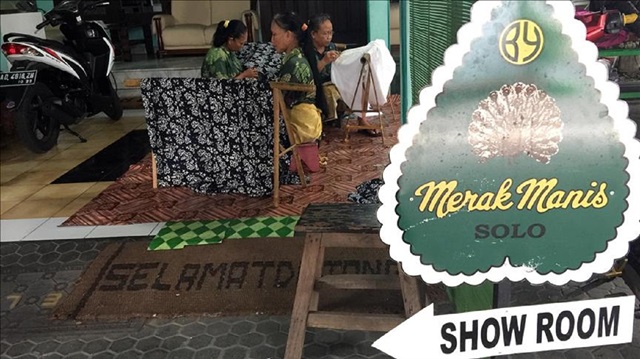
Three middle-aged women are sitting on a mat in front of the Batik Merak Manis Shop, in Laweyan Batik Village, Solo. In their laps, almost two meters of unfolded fabric.
They dipped the metal canting – a tool for drawing batik patterns with a container for wax– into the hot pan used for melting the wax.
Mulyati, Sumiati, and Widiastuti painted the fabric with canting, once in while blowing the liquid wax inside their canting. Their fingers move skillfully as they make the patterns.
“It is very easy,” said Mulyati, 62, to Anadolu Agency who visited them last week.
Mulyati learned to make batik when she was eight years old. At the beginning, her hands often blistered. However, her spirit did not easily recede.
During her childhood, Mulyati said that Laweyan Batik Village was one of the largest batik producing center in Indonesia. Since 19th century, this village was known as batik village. Most of the population become buyer of batik crafter.
In 1970s, batik industry was in bleak due to a massive selling of Chinese batik printing. Currently, the industry in the 25 hectares area gets back on track. There are at least three batik crafters at almost every shop.
Unfortunately, there is no sight of young crafters.
“My children or grandchildren cannot make batik. Maybe they are too lazy to learn it,” said Mulyati.
The scarcity of Indonesian young people who become batik craftsmen is probably not related to their love for the culture, but more likely due to financial problems.
With seven hours a day and six days a week, Mulyati only earns Rp 35,000 per day or Rp 840,000 per month, which still below the minimum wage set by Solo government, Rp 1,5 million per month. Meanwhile, younger crafters earn lower wages, which is about Rp 30,000 – 32,000 in a day.
In the end, the young crafters choose to work in batik printing sector. There are at least 20 job positions at Laweyan batik industry, such as sewing, stamping, printing, distributing, and designing.
The Laweyan Batik Village Development Forum (FPKBL) Chairman Alpha Febela Priyatmono said they continue their efforts to introduce batik to the younger generation, such as through Laweyan Three Generations Program that was held in September, which displayed batik crafter profiles from three generations; older generation, adults, and teenagers.
"Nowadays, a lot of teenagers are interested to make batik," said Alpha.
He added that introducing batik is not limited to learn making batik, but can be achieved through other activities such as education or cultural tourism.
Therefore, FPKBL wants to maintain the existence of Laweyan Batik Village as a cultural heritage site, so tourists who visit Laweyan can feel the cultural atmosphere from the batik village.
"We can buy and sell products through online store, but to enjoy the art, we should come and enjoy the taste in person, " said Alpha.
Indonesian batik was inscribed on the UNESCO Representative List of the Intangible Cultural Heritage of Humanity on October 2, 2009. That moment became the turning point of batik industry.
There are at least 101 batik centers, mostly in Central Java, West Java, East Java, and Yogyakarta. All of them are Small and Medium Independent Industries (IKM).
According to the Ministry of Industry data, the number of workers in IKM batik reaches 15,000 people.
In 2016, the export value of batik products reached USD 149,9 million. In the first half of 2017 it reached USD 39,4 million (Rp 528 billion) with Japan, US, and Europe as the main market destinations.
While the number is high, unfortunately the younger generation is not that interested to work as craftsmen.
Deputy Head of Indonesian Creative Economy Agency Ricky Joseph Pesik said that younger generation are less interested in batik creative industry.














